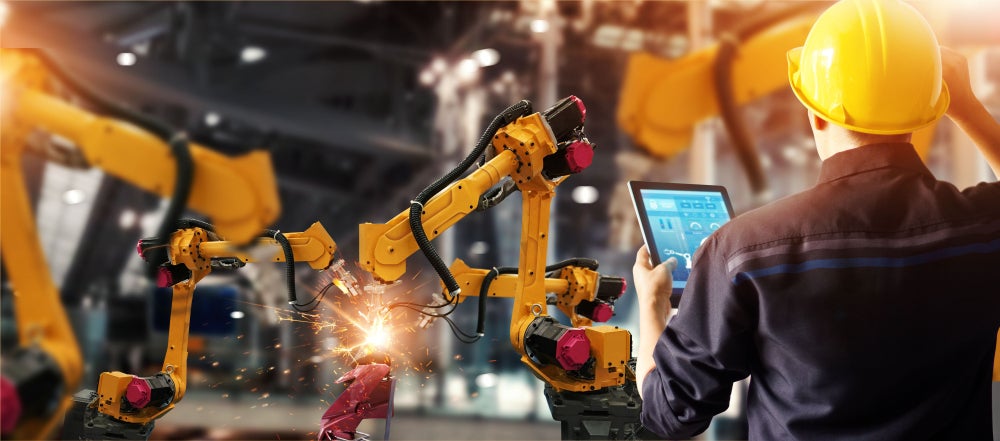
Imagine programmable factories, oil fields, offices, warehouses, mines and supply chains which are all undergirded by ‘Social Networks of Big Iron’, jet engines, wind turbines, locomotives, tractors, drills and milling machines. What is the Industrial Internet of Things in business and why is it relevant?
The Industrial Internet of Things (IIoT) is dubbed in some circles as the Internet of Really Important Things. It will redefine the way much of the global industrial economy operates and is all part of a fast-evolving underground, the second economy of intelligent industrial machines running their own logic and communicating with each other.

Access deeper industry intelligence
Experience unmatched clarity with a single platform that combines unique data, AI, and human expertise.
The Industrial Internet is one of the market segments that fall under the umbrella term, the Internet of Things, which refers to the concept of connecting physical objects, like clothes, watches, cars, fridges, heaters and factory machines, to the Internet.
Why does the Industrial Internet matter for business?
Worldwide demand for IIoT goods and services are forecast to rise to $500bn per annum by 2020, compared to an estimate of just $20bn three years ago, according to Accenture. Around 40% to 50% of world economic activity will quite likely to be down to autonomous machine-to-machine (M2M) operations by then, says the Santa Fe Institute. By 2030, GE points to forecasts that suggest that the Industrial Internet may account for $15tn of global GDP.
The momentum behind the IIoT is almost certainly unstoppable. But governments have two big concerns: national security weaknesses and a lack of sufficiently skilled labour. There is a severe shortage of mathematicians, data scientists, machine-learning experts and roboticists, even as unemployment in traditional industries rises across the world.
For the IIoT to work efficiently, streamed data from a multitude of sources must be collected, and often analysed in real-time, with the results fed back to the industrial applications that generated the data. While most business-critical data analysis is still performed using batch processing techniques today – often with humans making final revisions – in the future, data analytics for the IIoT will need to be performed almost entirely by machines on a real-time basis. The quantity of data (and video) and their real-time requirements will require enhancements to underlying Internet infrastructure from IaaS and managed cloud providers. The use of edge processing also makes it easier to process data and perform analytics closer to the site of collection, making many IoT applications less reliant on public networks and less expensive than transmission to and from the cloud.

US Tariffs are shifting - will you react or anticipate?
Don’t let policy changes catch you off guard. Stay proactive with real-time data and expert analysis.
By GlobalDataWhat are the big themes around the Industrial Internet?
Chip Layer
Sensors
The basic source of the streaming data that powers the Internet of Things comes from sensors. These sensors include accelerometers, heat and humidity components, pressure components, cameras and microphones. In the early years of the IIoT cycle, much of the value may be in the sensor manufacturers.
Embedded chips
Together with sensors, microcontroller units, which tell these sensors what to do, should also do well in the first couple of years of the IIoT cycle. Moreover, microcontroller units are getting more complex, because there is a trend towards multiple sensor capabilities in a single connected device.
Since there is, as yet, no common wireless communication standard for the Internet of Things, manufacturers who wish to connect their products to the Industrial Internet are forced to use communications chips with several wireless technologies, for example, 3G, 4G, Wi-Fi and Bluetooth built into them.
Connectivity Layer
Edge devices
Edge devices, such as routers or gateways, provide an entry point into any industrial data network.
Telecom networks
Most telecom operators are watching the IIoT technology cycle from the sidelines, too scared and too clueless to enter the race. Many others hope that revenues from M2M networks might simply fall into their laps.
Data Layer
Analytics
For the Industrial Internet of Things to work efficiently, streamed data from a multitude of sources must be analysed in real-time, with the results fed back to the industrial applications that generated the data. Whilst most business-critical data analysis is still performed using batch processing techniques today, often with humans making final revisions, data analytics for the IIoT may need to be performed almost entirely by machines on a real-time basis.
Cloud infrastructure
Cloud infrastructure is the foundation for the next generation of technology cycles, from Big Data to mobile commerce to the Internet of Things, all of which are delivered through cloud services. In a sense, cloud infrastructure acts as the operating system for accessing cloud services in the same way that Apple’s iOS or Google’s Android is the dominant operating systems for accessing the mobile Internet.
Security
Cyberattacks remain a significant risk for investors in the Industrial Internet of Things. For many of the larger software conglomerates likely to be involved in the IIoT, cybersecurity continues to be a weak point. They are likely to fill this vulnerability by buying cybersecurity companies. Their focus could be on ‘unified threat management’, the most complex area within cybersecurity today.
Control Layer
Industrial apps and Industrial Operating systems
Intelligent machines and industrial applications all need to be controlled from a central hub. Arguably this is where the smart investors could place bets. These machines and apps need to communicate with one another in an Industrial Internet Cloud that is far more robust, reliable and fast than the consumer Internet clouds run by Amazon and Google.
This article was produced in association with GlobalData Thematic research. More details here about how to access in-depth reports and detailed thematic scorecard rankings.







